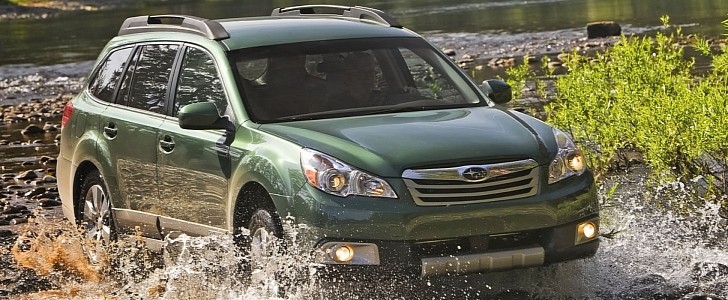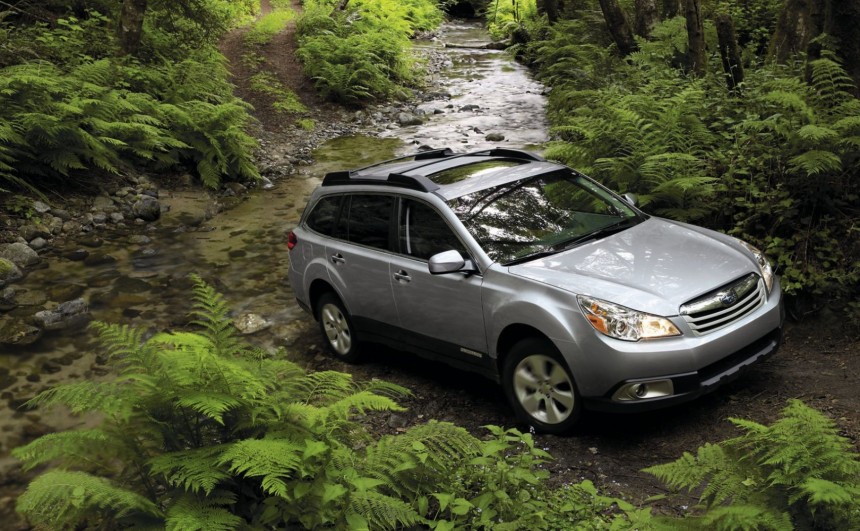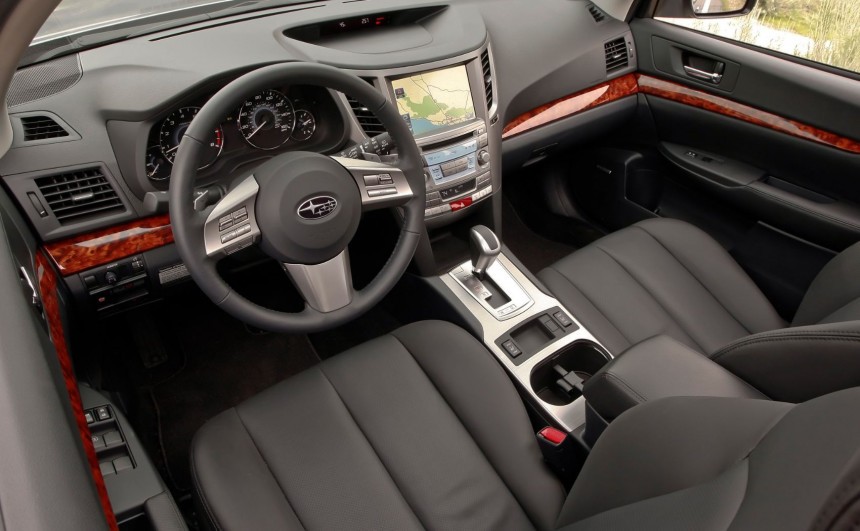Among used crossovers, there are not many models that rise to the same level of reliability as the 2009–2014 Subaru Outback. However, that doesn’t mean that the model is problem-free, so here are the most common issues you should look out for.
Launched in 2009 for the 2010 model year, the Outback was well received for its extensively updated bodywork and interior space where rear-seat legroom became abundant.
All models featured AWD, and U.S. customers could choose between a 170-hp 2.5-liter flat-four or a 256-hp 3.6-liter flat-six. The latter engine was available with a five-speed automatic, while the less powerful models came with either a six-speed manual or a Lineartronic CVT.
Built until 2014, this Subaru gained a reputation for being reliable, so prices for a used model haven’t dropped significantly. Still, these days you can buy a well-maintained one with a four-cylinder for about $9,000, whereas models with the bigger engine go for about $12,000. Of course, low mileage third-generation Outback Limited or Premium trims with a few optional extras can cost up to twice as much.
Regardless of what model you choose, keep in mind that this is a seven- to twelve-year-old vehicle, and even if it’s known for dependability, several issues can occur.
An issue that plagues many engines, including the Outback’s two boxer engines, is excessive oil consumption. The causes for this vary and include worn gaskets or piston rings.
If the car’s low on oil, you may hear a metallic click when driving under load. Because there’s insufficient oil inside the engine, friction increases, and the internals become noisy.
However, the most obvious sign that the car needs oil is the dedicated warning light which will light up in the dashboard. If this happens, the vehicle should be pulled over, and after the engine cools down, it should be topped up with oil.
I recommend studying the maintenance records to see when the last oil change was done. After that, check the current level as well as the mileage, and if the Outback is low on oil after around 5,000 miles (8,048 km), it’s not generally a good sign. Of course, this is not foolproof, as the previous owner can simply top it off before you meet, so it’s always a good idea to have the car checked by a Subaru-certified mechanic.
Symptoms of this issue include increased engine oil and coolant consumption, black oil coming out of the tailpipe, or even oil spots underneath the vehicle. Also, remove the coolant reservoir cap, and if you see a foamy, cappuccino-like substance forming, it means the gasket needs to be replaced immediately.
It is not an easy or a cheap fix since the whole engine needs to be taken out and disassembled, so pay close attention to this issue.
On some 2013 Outbacks (and even other Subaru models), the steering column shaft has an annoying manufacturing fault and tends to become loose. That is easy to spot when you’re inside the vehicle as the steering wheel feels wobbly.
Subaru issued a recall for this component, so in the unlikely case that the previous owner wasn’t aware of this recall and the vehicle shows signs of a faulty shaft, you can use this as an opportunity to negotiate the price and have it fixed for free.
When buying a used Outback, the only way you can check this is by measuring the voltage that’s coming out of the alternator to see if there are any irregularities, but this requires a voltmeter.
Although one or several issues on this list can occur, the fourth-generation Outback is a very reliable vehicle, so if you’re not on an extremely tight budget, you should end up with a very good vehicle.
As always, we recommend that you thoroughly check the maintenance history and perform a pre-purchase inspection before you seal the deal.
All models featured AWD, and U.S. customers could choose between a 170-hp 2.5-liter flat-four or a 256-hp 3.6-liter flat-six. The latter engine was available with a five-speed automatic, while the less powerful models came with either a six-speed manual or a Lineartronic CVT.
Built until 2014, this Subaru gained a reputation for being reliable, so prices for a used model haven’t dropped significantly. Still, these days you can buy a well-maintained one with a four-cylinder for about $9,000, whereas models with the bigger engine go for about $12,000. Of course, low mileage third-generation Outback Limited or Premium trims with a few optional extras can cost up to twice as much.
Regardless of what model you choose, keep in mind that this is a seven- to twelve-year-old vehicle, and even if it’s known for dependability, several issues can occur.
Excessive Oil Consumption
If the car’s low on oil, you may hear a metallic click when driving under load. Because there’s insufficient oil inside the engine, friction increases, and the internals become noisy.
However, the most obvious sign that the car needs oil is the dedicated warning light which will light up in the dashboard. If this happens, the vehicle should be pulled over, and after the engine cools down, it should be topped up with oil.
I recommend studying the maintenance records to see when the last oil change was done. After that, check the current level as well as the mileage, and if the Outback is low on oil after around 5,000 miles (8,048 km), it’s not generally a good sign. Of course, this is not foolproof, as the previous owner can simply top it off before you meet, so it’s always a good idea to have the car checked by a Subaru-certified mechanic.
Leaking Head Gaskets
Another common problem with the four-cylinder engine is a failing cylinder head gasket. Because these engines employ thin single-layer gaskets, they will wear out prematurely, which can cause coolant or oil leaks.Symptoms of this issue include increased engine oil and coolant consumption, black oil coming out of the tailpipe, or even oil spots underneath the vehicle. Also, remove the coolant reservoir cap, and if you see a foamy, cappuccino-like substance forming, it means the gasket needs to be replaced immediately.
It is not an easy or a cheap fix since the whole engine needs to be taken out and disassembled, so pay close attention to this issue.
Loose Steering Shaft
Subaru issued a recall for this component, so in the unlikely case that the previous owner wasn’t aware of this recall and the vehicle shows signs of a faulty shaft, you can use this as an opportunity to negotiate the price and have it fixed for free.
Headlight Bulbs Burn Out Frequently
Although this is seemingly a minor issue, it can be extremely annoying. According to technicians with extensive experience with Subaru vehicles, this is usually related to the alternator’s voltage regulator.When buying a used Outback, the only way you can check this is by measuring the voltage that’s coming out of the alternator to see if there are any irregularities, but this requires a voltmeter.
Although one or several issues on this list can occur, the fourth-generation Outback is a very reliable vehicle, so if you’re not on an extremely tight budget, you should end up with a very good vehicle.
As always, we recommend that you thoroughly check the maintenance history and perform a pre-purchase inspection before you seal the deal.










